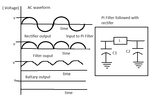scorrpeio
Full Member level 5
Hello,
Few basic questions...
1. Noise is created because of different reasons. I read that while AC is rectified to DC using rectifier, a noise is generated. But nowhere it is mentioned How? (It was an article proving battery is the clean source of power than rectifier.)
2. Can anyone throw a light on how noise is generated in rectification?
3. Basically, what exactly is noise? Is it just an unwanted voltage at unwanted time and place?
4. When we say, capacitor filters noise, what does it exactly do? I know that capacitor absorbs noise. But, what does exactly happen during that process?
5. Normally, noise absorbing ceramic capacitors dont have polarity. How do they exactly function?
6. We often connect noise absorbing capacitor in parallel. Why not in series? (This question might be ridiculous for those who are experts, but I am asked this by my junior and I could not answer it. )
)
Few basic questions...
1. Noise is created because of different reasons. I read that while AC is rectified to DC using rectifier, a noise is generated. But nowhere it is mentioned How? (It was an article proving battery is the clean source of power than rectifier.)
2. Can anyone throw a light on how noise is generated in rectification?
3. Basically, what exactly is noise? Is it just an unwanted voltage at unwanted time and place?
4. When we say, capacitor filters noise, what does it exactly do? I know that capacitor absorbs noise. But, what does exactly happen during that process?
5. Normally, noise absorbing ceramic capacitors dont have polarity. How do they exactly function?
6. We often connect noise absorbing capacitor in parallel. Why not in series? (This question might be ridiculous for those who are experts, but I am asked this by my junior and I could not answer it.
Last edited:
